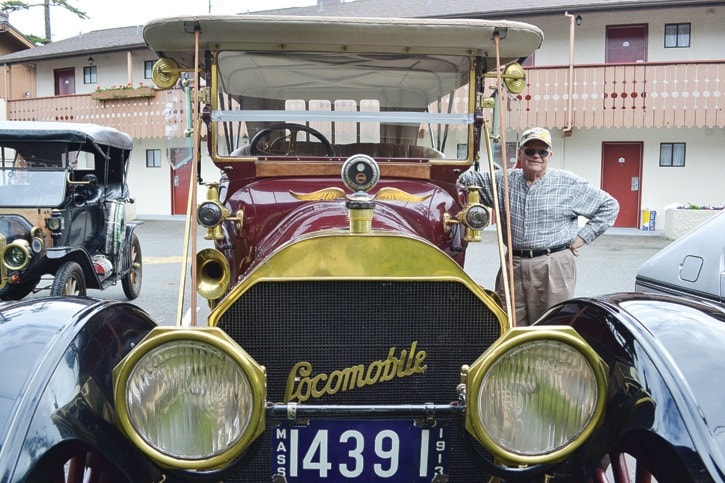No, that wasn’t Chitty Chitty Bang Bang you saw cruising along the Island Highway earlier this week.
That, car lovers, was a 1911 Stanley Steamer, a beauty of an automobile that went the way of the dodo bird once gas engines became the power plants of choice.
“It sure puts out a lot of steam when it’s raining,” says Mike May, 69, of Woodstock, Vermont, who’s along for the long ride with his buddy Don Bourdon, 64, the owner of the steam-powered car.
The old friends and their wives are riding with a group of 15 vintage cars taking part in Red Rock Rendezvous 2012. They arrived in Campbell River Sunday night and stayed for another night at the Best Western before continuing the trip down Island.
The road trip takes place every two years and attracts a select group of vintage car owners from across the United States. This year’s three-week journey began earlier this month in Missoula, Montana, and will end there on June 29.
“To take a car like this, 2,500 or 3,000 miles, is asking a lot out of hundred-year-old machinery,” says Jack Miller, 73, of Fayetteville, Georgia.
The entourage includes two Rolls Royce Silver Ghosts – including a royal blue 1913 model valued at about $1 million – a 1913 Locomobile, a 1914 Ford Model T, and Miller’s 1913 Stevens-Drury, to name a few.
“This was one of the most expensive cars of its day,” says Miller, with a pat of the rear fender. “By 1915, Stevens-Drury was out of business.”
The year 1915 is also “too new” for the Rendezvous riders. Cars allowed can’t be made past 1914 and the oldest of the bunch are 1910-1911 models.
“Anything earlier than that, they’re just too small to go on a trip like this,” notes Harvey Hansen of Salt Lake City, Utah.
Hansen, 77, is the owner of the 1913 Locomobile, which was one of the most expensive American-built cars of its day with a price tag of about $5,200. The car got its name because the company’s first vehicles were steam-powered, like the old locomotives.
“It was restored in 1959 and I bought it as is. I didn’t do any restoration on it, just got it running better,” says Hansen, as he starts playing with all the funky little noise-makers on board. “It’s got all the horns, bells and whistles!”
During their layover in Campbell River, the drivers donned grease clothes to lube their cars, change oil, tighten bolts, and to repair whatever else needs fixing in order for the vehicles to make it another 1,600 kilometres.
“Today’s a layover day for fixin’ anything,” says Hansen who’s on his fifth trip. “One time I broke down in Arizona. I had to trailer it home, but those things happen. Some things you can fix and some things you can’t.”
Sometimes the owners have to scout out machinists to make custom replacement parts and sometimes they come across other vintage car lovers who have what they need.
As this year’s tour crossed Washington State, the drive shaft on the 1911 Cadillac broke. Fortunately, a guy they met in Bellingham had the right parts which meant the Caddy could keep going.
“That’s just luck,” Hansen chuckles.
Surprisingly, tires are relatively easy to find and cost about $300 apiece. But there are other things on these cars that don’t look so old, like the electronic GPS map in the front of Miller’s Stevens-Drury.
“In a lot of these cars the brakes have been modernized, they have running lights and turn signals,” says Miller, explaining it makes the vehicles safer from the long trips.
The drivers travel in groups of two to three vehicles, this way they don’t cause long line-ups of impatient motorists, and they also travel on back and side roads as much as possible.
“My cruising speed is 45 to 50 miles an hour,” says Hansen. “There’s another green (Locomobile) in the group and he got it up to 80 on a track. That would make me nervous.”
That kind of speed also wouldn’t sit well with Hansen’s wife of 58 years, Clara, who’s enjoying the journey.
“I hadn’t even heard of a Locomobile until he told me he wanted to buy one. There aren’t many,” she notes.
The other interesting thing about all these cars is the placement of the steering wheel, which is on the right side. The reason being that the cars were based on the horse-and-buggy era when the driver was more interested in staying out of the righthand ditch and this allowed them to keep a close eye on the edge of the rough roads.
On Tuesday morning, the tour got back on the road – it takes 20 minutes to get the Stanley Steamer going, but then it will run all day – as the group headed for Tofino, then to Victoria and then onto Kokanee Glacier Park, before making the final jaunt to Missoula.
And everywhere they go, they turn heads.
“You’re seeing some of the greatest dinosaurs on the road,” says Miller.
